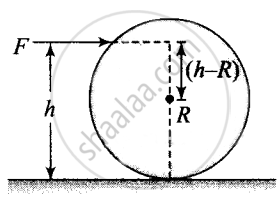Advertisements
Advertisements
Question
A uniform sphere of mass m and radius R is placed on a rough horizontal surface (Figure). The sphere is struck horizontally at a height h from the floor. Match the following:

| Column I | Column II | |
| (a) h = R/2 | (i) | Sphere rolls without slipping with a constant velocity and no loss of energy. |
| (b) h = R | (ii) | Sphere spins clockwise, loses energy by friction. |
| (c) h = 3R/2 | (iii) | Sphere spins anti-clockwise, loses energy by friction. |
| (d) h = 7R/5 | (iv) | Sphere has only a translational motion, looses energy by friction. |
Solution
| Column I | Column II | |
| (a) h = R/2 | (iii) | Sphere spins anti-clockwise, loses energy by friction. |
| (b) h = R | (iv) | Sphere has only a translational motion, looses energy by friction. |
| (c) h = 3R/2 | (ii) | Sphere spins clockwise, loses energy by friction. |
| (d) h = 7R/5 | (i) | Sphere rolls without slipping with a constant velocity and no loss of energy. |
Explanation:
Mass of the sphere = m
Radius = R
h = height from the floor
The sphere will roll without slipping when ω = V/R
Where v is linear velocity and to is the angular velocity of the sphere.
Now, angular momentum of the sphere is about centre of mass .....[We are applying conservation of angular momentum just before and after struck.]

Then by the law of conservation of angular momentum
`mv(h - R) = I_ω`
`mv(h - R) = 2/5 mR^2 v/R`
`h - R = 2/5 R`
`h = 2/5 R +R = 7/5 R`
Therefore, the sphere rolls without slipping with a constant velocity and no loss of energy. Thus (d) - (i)
Torque due to force `F = τ = (h - R) xx F`
If τ = 0, h – R = 0 and thus h = R
In this case, the sphere will only have a translation motion and slip against the force of friction. Thus (b) - (iv)
For clockwise rotation of the sphere τ > 0
`(h - R) xx F > 0`
Or `h > R`, thus (c) - (ii)
For anti-clockwise rotation `τ < 0`
`(h - R) xx F < 0`
`h < R`,Thus (a) - (iii)
APPEARS IN
RELATED QUESTIONS
A solid cylinder of mass 20 kg rotates about its axis with angular speed 100 rad s–1. The radius of the cylinder is 0.25 m. What is the kinetic energy associated with the rotation of the cylinder? What is the magnitude of the angular momentum of the cylinder about its axis?
If several forces act on a particle, the total torque on the particle may be obtained by first finding the resultant force and then taking torque of this resultant. Prove this. Is this result valid for the forces acting on different particles of a body in such a way that their lines of action intersect at a common point?
A body is in translational equilibrium under the action of coplanar forces. If the torque of these forces is zero about a point, is it necessary that it will also be zero about any other point?
When a force of 6⋅0 N is exerted at 30° to a wrench at a distance of 8 cm from the nut it is just able to loosen the nut. What force F would be sufficient to loosen it if it acts perpendicularly to the wrench at 16 cm from the nut?

A 6⋅5 m long ladder rests against a vertical wall reaching a height of 6⋅0 m. A 60 kg man stands half way up the ladder.
- Find the torque of the force exerted by the man on the ladder about the upper end of the ladder.
- Assuming the weight of the ladder to be negligible as compared to the man and assuming the wall to be smooth, find the force exerted by the ground on the ladder.
A particle is moving with a constant velocity along a line parallel to the positive X-axis. The magnitude of its angular momentum with respect to the origin is, ______
A rope is wound around a hollow cylinder of mass 3 kg and radius 40 cm. What is the angular acceleration of the cylinder if the rope is pulled with a force of 30 N?
The net external torque on a system of particles about an axis is zero. Which of the following are compatible with it?
- The forces may be acting radially from a point on the axis.
- The forces may be acting on the axis of rotation.
- The forces may be acting parallel to the axis of rotation.
- The torque caused by some forces may be equal and opposite to that caused by other forces.
The position vector of 1 kg object is `vecr = (3hati - hatj)` m and its velocity `vecv = (3hati + hatk)` ms-1. The magnitude of its angular momentum is `sqrtx` Nm where x is ______.
The magnitude of the torque on a particle of mass 1 kg is 2.5 Nm about the origin. If the force acting on it is 1 N, and the distance of the particle from the origin is 5 m, the angle between the force and the position vector is (in radians) ______.
